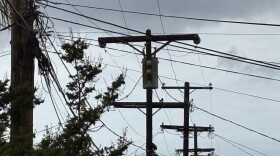This story is part of the America's Wall project.
In a stucco house a quarter mile north of Mexico, a 78-year-old self-described “vigilante” with cropped silver hair and blue eyes prepared for a patrol of his property with two black labrador mixes, Shadow and Inky.
“I consider myself an American citizen. Most people don’t anymore,” Bob Maupin said. “I love my country, I believe in the Constitution. … It is my duty to protect the country from people invading it.”
He pulled on a camouflage hat and black gloves, buckled on a bulletproof vest and slung an AR-10 rifle over his shoulder.
“Come on, boys,” Maupin called out to his dogs.
They followed him out of his house in the tiny eastern San Diego County community of Boulevard, population about 460.
The southern edge of Maupin’s 250-acre property — a 15-minute walk from his house — is lined by two fences: his own and the U.S. government’s. Maupin placed his hand on the chain-link fence it took him five years to build and frowned at the government fence a few footsteps south of it.
The government fence is made of recycled helicopter landing mats from the Vietnam War. It stands about 10 feet tall. The ridges on the corrugated steel mats are horizontal and can be gripped and balanced on by people attempting to scale the fence.
“It has steps in it, so they can walk and climb over,” Maupin said.
It was constructed in the 1990s as part of Democratic President Bill Clinton’s Operation Gatekeeper, a border security initiative that focused on the San Diego-Tijuana region.
When the landing mat fence proved less effective than expected, the U.S. invested in a secondary fence running parallel to parts of the primary fence — but not along Maupin’s property.
Soon, he said, his backyard became a popular route for migrants crossing illegally into the United States.
“Before Operation Gatekeeper, it was wonderful,” Maupin said. “We had a good rapport with the people down south. They didn’t speak English, but it was always, 'Hi,' you know? And what not. But then after Operation Gatekeeper, (Border Patrol) watched the gates, and they didn’t care about the areas between the gates or the ports of entry. So that’s when the cartels got involved (in human smuggling) and were bringing people up from Tijuana, Tecate.”
“Without borders, you’re no longer a country.”
Back in his house, Maupin keeps a stack of photos in a folder that document his ordeals over the years with migrants who entered the U.S. illegally. They show large groups of people crossing the border onto his property and gaping holes cut into his fence.
“Legal immigrants — love ‘em,” Maupin said. “People breaking the law — that’s my problem. And the government not enforcing it. ... Without borders, you’re no longer a country.”
Maupin is a direct and literal man. He deals in actual nuts and bolts, having run an auto parts business for three decades. “I’m about as subtle … as a sledgehammer,” he said. In his retirement, he restores World War II vehicles for fun. He cleans backing plates, installs wheel cylinders, replaces lines and hoses. He built a half-track from the frame up.
He said he built his fence to compensate for what he sees as flaws in the government’s wall. His fence is also imperfect, marred with patches — slabs of corrugated steel and jumbled-up chain link — in all the places that the smugglers have cut it with torches and saws. But it is topped with razor wire, making it harder to climb than the government’s fence.
Even though the wall along his property has caused him problems, Maupin supports Republican President Donald Trump’s goal of extending and fortifying the current border fence. He said he thinks the illegal entries through his property would have never been an issue if the U.S. government had built a strong, impermeable wall in the first place.
It has been years since Maupin caught anyone on his land — illegal immigration has slowed to a trickle in recent years in part because of an improving Mexican economy — but he still finds new breaks in his fence.
“Over the years, my wife and I have had to spend $25,000 in fence repair and property repair because of these people,” he said.
Maupin teared up when he talked about his late wife, Jeanette. As a boy, he dreamed of becoming a Marine. But in high school, he met Jeanette. He said she would have had “nervous breakdowns” during his deployments, so he decided to stay in town and start his auto parts business instead. Together for nearly six decades, they ran their business and raised their two children.
Jeanette died last year in August at the age of 76.
“Before she died, she told me to get on with my life and not waste my time feeling sorry for myself,” Maupin said, his eyes red and wet. “But she was my life.”

















